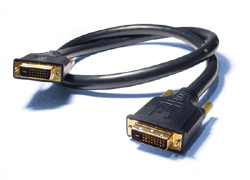DVI Connection
DVI stands for Digital Visual Interface. Just as the name suggests, DVI cable is dedicated completely to transmitting digital video signals. DVI cable is becoming more and more popular as the price of high-definition televisions (HDTV) fall, making them more accessible to the average person.
Two Types of DVI Cables
There are two types of DVI cables; single link and dual link. Single Link DVI is capable of transferring video at a resolution of 1920x1080 as opposed to Dual Link DVI that is able to carry video signals with a resolution of 2048x1536. While you can use Dual Link DVI cable with a Single Link DVI connection, it will not send a higher resolution transfer.The division in DVI cables is not based on a difference in quality. Dual Link does not mean twice as good as Single Link. It is only an indication of the video resolution the cable is able to transfer.

Three Types of DVI Connections
DVI cable connections come in three varieties; DVI-A, DVI-D, DVI-I. DVI-A stands for DVI-Analog; it is used for sending a high-resolution analog signal from a digital source. While it is high-resolution, there is signal degradation caused by the conversion from digital to analog.DVI-D refers to DVI-Digital; it is a completely digital interface. This is in contrast to the other two types of DVI connections. The DVI-D dedication to digital video signals means that this information can be sent between home theater components without conversions. Sidestepping the conversion process allows for a cleaner signal transfer, free of the artifacts multiple conversions can create.
DVI-I stands for DVI-Integrated; this type of connection is capable of sending either analog or digital signals. The DVI-I connection is capable of transmitting only a single type of signal at a time. Be aware that it is not able to be used for a digital source and an analog receiving component or vise versa. The two components must be of the same type.